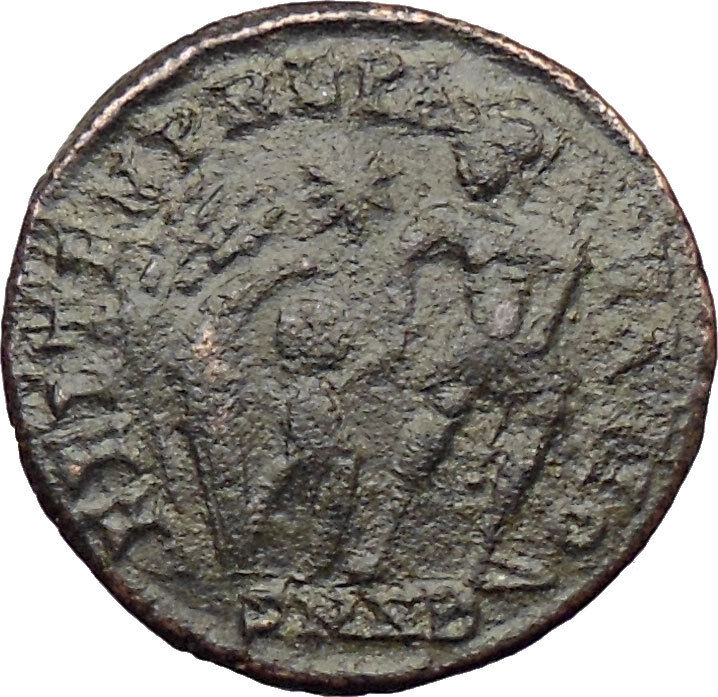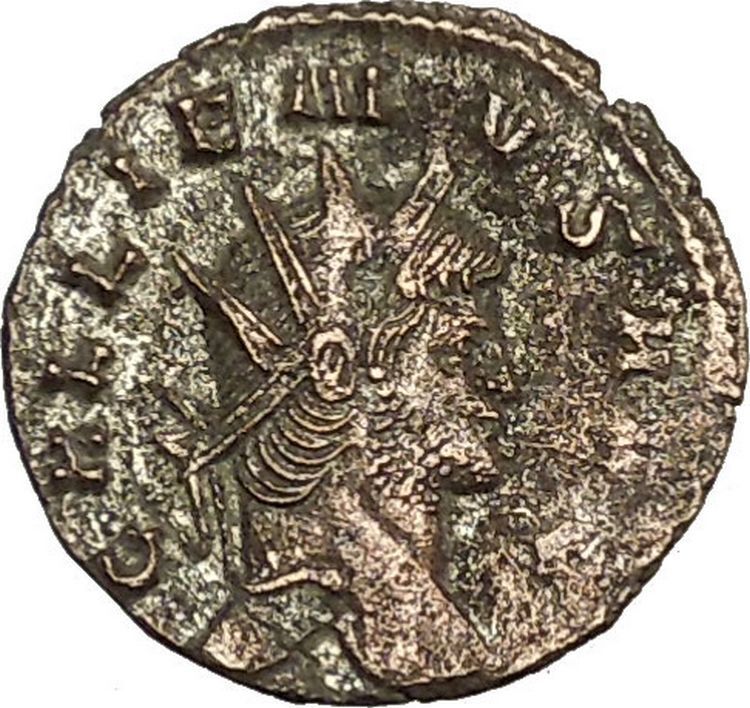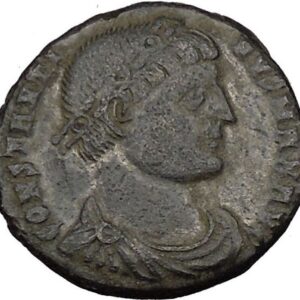|
Constantius Gallus – Roman Caesar:
351-354 A.D. –
Bronze AE3 18mm (2.30 grams) Nicomedia mint: 351-354 A.D.
Reference: RIC 85
DN FL CL CONSTANTIVS NOB CAES, bare-headed, draped & cuirassed bust rt.
FEL TEMP REPARATIO, soldier spearing a fallen horseman, who is wearing a
Phrygian helmet
SMNЄ in ex.
You are bidding on the exact item pictured,
provided with a Certificate of Authenticity and Lifetime Guarantee of
Authenticity.
The Phrygian helmet, also known as the Thracian helmet,was a
type of helmet that originated in
Classical Greece
and was widely use in
Thrace
,
Dacia
,
Magna Graecia
and the
Hellenistic
world until well into the
Roman Empire
.
Characteristics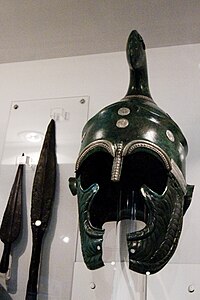
The names given to this type of helmet are derived from its shape, in
particular the high and forward inclined apex, which resembles the
caps
(usually of leather) habitually worn by
Phrygian
and
Thracian
peoples. Like other types of Greek
helmet, the vast majority of Phyrgian helmets were made of bronze. The skull of
the helmet was usually raised from a single sheet of bronze, though the
forward-pointing apex was sometimes made separately and riveted to the skull.
The skull was often drawn out into a peak at the front, this shaded the wearer’s
eyes and offered protection to the upper part of the face from downward blows.
The face was further protected by large cheekpieces, made separately from the
skullpiece. Sometimes these cheekpieces were so large that they met in the
centre leaving a gap for the nose and eyes. When constructed in this manner they
would have embossed and engraved decoration to mimic a beard and moustache.
Use
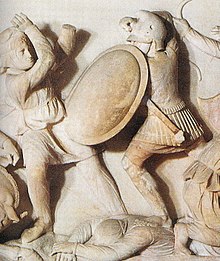
Ancient depiction of a Macedonian infantryman (right). He is
equipped with a typical Phrygian/Thracian helmet with a peak.
Alexander Sarcophagus
.
The Phrygian helmet was worn by
Macedonian
cavalry in King
Philip
‘s day but his son
Alexander
is said to have preferred the
open-faced
Boeotian helmet
for his cavalry, as recommended
by Xenophon
.[4]
The royal burial in the
Vergina
Tomb contained a helmet which was a
variation on the Phrygian type, exceptionally made of iron, this would support
its use by cavalry. The Phrygian helmet is prominently worn in representations
of the infantry of Alexander the Great’s army, such on the contemporary
Alexander sarcophagus
[5]
The Phrygian helmet was in prominent use at the end of the
Classical Era
and into the
Hellenistic period
, replacing the earlier ‘Corinthian‘
type from the 5th century BC.[
In antiquity, Phrygia (
Greek
: Φρυγία,
Ancient Greek: [pʰryɡía])
Turkish
:
Frigya) was a kingdom in the west central part of
Anatolia
, in what is now modern-day
Turkey
, centered around the
Sakarya River
.
The Phrygians
are most famous for their legendary
kings of the
heroic age
of
Greek mythology
:
Gordias
whose
Gordian Knot
would later be untied by
Alexander the Great
,
Midas
who turned whatever he touched to gold,
and
Mygdon
who warred with the
Amazons
. According to
Homer
‘s
Iliad
, the Phrygians were close allies of the
Trojans and participants in the
Trojan War
against the
Achaeans
. Phrygian power reached its peak in
the late 8th century BC under another, historical
King Midas
, who dominated most of western and
central Anatolia and rivaled
Assyria
and
Urartu
for power in eastern Anatolia. This
later Midas
was however also the last independent
king of Phrygia before its capital
Gordium
was sacked by
Cimmerians
around 695 BC. Phrygia then became
subject to Lydia
, and then successively to
Persia
,
Alexander
and his
Hellenistic
successors,
Pergamon
,
Rome and
Byzantium
. Phrygians were gradually assimilated
into other cultures by the early medieval era, and the name Phrygia passed out
of usage as a territorial designation after the
Turkish
conquest of Anatolia.
Origins
Inscriptions found at
Gordium
make clear that Phrygians spoke an
Indo-European
language with at least some
vocabulary similar to
Greek
, and clearly not belonging to the family
of
Anatolian languages
spoken by most of Phrygia’s
neighbors.
According to one of the so-called
Homeric Hymns
, the
Phrygian language
was not mutually intelligible
with Trojan.[3]
According to ancient tradition among Greek historians, the Phrygians
anciently migrated to
Anatolia
from the
Balkans
.
Herodotus
says the Phrygians were called
Bryges
when they lived in Europe.[4]
He and other Greek writers also recorded legends about King
Midas
that associated him with or put his
origin in
Macedonia
;
Herodotus
for example says a wild rose garden
in Macedonia was named after
Midas
.[5]
The Phrygians were also connected by some classical writers to the
Mygdones
, the name of two groups of people, one
of which lived in northern Macedonia and another in
Mysia
. Likewise the
Phrygians
have been identified with the
Bebryces
, a people said to have warred with
Mysia
before the
Trojan War
and who had a king named
Mygdon
at roughly the same time as the
Phrygians were said to have had a king named Mygdon. The classical historian
Strabo
groups Phrygians,
Mygdones
,
Mysians
,
Bebryces
and
Bithynians
together as peoples that migrated to
Anatolia from the Balkans
.[6]
This image of Phrygians as part of a related group of northwest Anatolian
cultures seems the most likely explanation for the confusion over whether
Phrygians
,
Bebryces
and Anatolian
Mygdones
were or were not the same people.
The apparent similarity of the
Phrygian language
to Greek and its
dissimilarity with the
Anatolian languages
spoken by most of their
neighbors is also taken as support for a European origin of the Phrygians.
Some scholars have theorized that such a migration could have occurred more
recently than classical sources suggest, and have sought to fit the Phrygian
arrival into a narrative explaining the downfall of the
Hittite Empire
and the end of the high Bronze
Age in Anatolia.[7]
According to this recent migration theory, the Phrygians invaded just before or
after the collapse of the
Hittite Empire
at the beginning of the 12th
century BC, filling the political vacuum in central-western Anatolia, and may
have been counted among the “Sea
Peoples” that Egyptian records credit with bringing about the Hittite
collapse. The so-called Handmade Knobbed Ware found in Western Anatolia during
this period has been suggested to be an import connected to this invasion.
However, most scholars reject such a recent Phrygian migration and accept as
factual the Iliad
‘s account that the Phrygians were
established on the
Sakarya River
before the
Trojan War
, and thus must have been there
during the later stages of the
Hittite Empire
, and likely earlier. These
scholars seek instead to trace the Phrygians’ origins among the many nations of
western Anatolia who were subject to the
Hittites
.[8]
This interpretation also gets support from Greek legends about the founding of
Phrygia’s main city
Gordium
by
Gordias
and of
Ancyra
by
Midas
,[9]
which suggest that Gordium and Ancyra were believed to be date from the distant
past before the
Trojan War
. Some scholars dismiss the claim of
a Phrygian migration as a mere legend, likely arising from the coincidental
similarity of their name to the
Bryges
.
No one has conclusively identified which of the many subjects of the
Hittites
might have represented early
Phrygians. According to a classical tradition, popularized by the Jewish-Roman
historian
Flavius Josephus
, the Phrygians can be equated
with the country called
Togarmah
by the ancient Hebrews, which has in
turn been identified as the Tegarama of Hittite texts and Til-Garimmu of
Assyrian records.
Josephus
called
Togarmah
“the Thrugrammeans, who, as the Greeks
resolved, were named Phrygians”. However, the Greek source cited by
Josephus
is unknown, and it is unclear if there
was any basis for the identification other than name similarity. Scholars of the
Hittites
believe Tegarama was in eastern
Anatolia – some locate it at
Gurun
– far to the east of Phrygia. Some
scholars have identified Phrygia with the
Assuwa
league, and noted that the
Iliad
mentions a Phrygian (Queen
Hecuba
‘s brother) named
Asios
.[10]
Another possible early name of Phrygia could be Hapalla, the name of the
easternmost province that emerged from the splintering of the Bronze Age western
Anatolian empire Arzawa
. However, scholars are unsure if Hapalla
corresponds to Phrygia or to
Pisidia
, further south.
A further claim made by
Herodotus
is that Phrygian colonists founded
the Armenian
nation.[11]
This is likely a reference to a third group of people called
Mygdones
living in northern
Mesopotamia
who were apparently allied to the
Armenians; Xenophon
describes them in his
Anabasis
in a joint army with the
Armenians
. However, little is known about these
eastern
Mygdones
and no evidence of
Phrygian language
in that region has been
found.
History
Around the
time of the Trojan war
The Iliad
describes the homeland of the Phrygians
on the
Sangarius River
, which would remain the center
of Phrygia throughout its history. According to the
Iliad
, Phrygia was famous for its wine and had
“brave and expert” horsemen.
According to the Iliad
, before the
Trojan War
, a young king
Priam
of
Troy had taken an army to Phrygia to support it in a war against the
Amazons
. Homer calls the Phrygians “the people
of
Otreus
and godlike
Mygdon
.[12]
According to Euripides
,
Quintus Smyrnaeus
and others, this Mygdon’s
son, Coroebus
, fought and died in the
Trojan War
; he had sued for the hand of the
Trojan princess
Cassandra
in marriage.
According to the
Bibliotheca
, the Greek hero
Heracles
slew a king Mygdon of the
Bebryces
in a battle in northwest Anatolia that
if historical would have taken place about a generation before the
Trojan War
. According to the story, while
traveling from Minoa
to the
Amazons
, Heracles stopped in
Mysia
and supported the
Mysians
in a battle with the
Bebryces
.[13]
According to most interpretations,
Bebryces
is an alternate name for Phrygians and
this Mygdon is the same person mentioned in the
Iliad
.
King Priam
married a Phrygian princess,
Hecuba
,[14]
and maintained a close alliance with the Phrygians, who repaid him by fighting
“ardently” in the
Trojan War
against the Greeks.
There are indications in the Iliad that the heart of the Phrygian country was
further north and downriver than it would be in later history. The Phrygian
contingent arrives to aid
Troy coming from
Lake Ascania
in northwest Anatolia, and is led
by Phorcys
and
Ascanius
, an apparent eponym. The
Iliad
calls the Phrygians “the people of
Otreus
and godlike Mygdon”: the name Otreus
could be an eponym for
Otrea
, a place on the Ascanian Lake in the
vicinity of the later
Nicaea
, and the name Mygdon is clearly an
eponym for the
Mygdones
, a people said by
Strabo
to live in northwest Asia Minor, and who
appear to have sometimes been considered distinct from the
Phrygians
.[15]
However,
Pausanias
believed that Mygdon’s tomb was
located at
Stectorium
in the southern Phrygian highlands,
near modern
Sandikli
.[16]
In one of the so-called
Homeric Hymns
, Phrygia is said to be “rich in
fortresses” and ruled by “famous
Otreus
“.[17]
Peak and destruction of the Phrygian kingdom

Detail from a reconstruction of a Phrygian building at Pararli,
Turkey, 7th–6th Centuries BC; Museum of Anatolian Civilizations,
Ankara
. A griffin, sphinx and two
centaurs are shown.
During the 8th century BC the Phrygian kingdom with its capital at
Gordium
in the upper
Sakarya River
valley expanded into an empire
dominating most of central and western Anatolia and encroaching upon the larger
Assyrian Empire
to its southeast and the
kingdom of Urartu
to the northeast.
According to the classical historians
Strabo
,[18]
Eusebius
and
Julius Africanus
, the king of Phrygia during
this time was another Midas
. This historical
Midas
is believed to be the same person named
as Mita in Assyrian texts from the period and identified as king of the
Mushki
. Scholars figure that Assyrians called
Phrygians “Mushki” because the Phrygians and
Mushki
, an eastern Anatolian people, were at
that time campaigning in a joint army.[19]
This Midas is thought to have reigned Phrygia at the peak of its power from
about 720 BC to about 695 BC (according to
Eusebius
) or 676 BC (according to
Julius Africanus
). An Assyrian inscription
mentioning “Mita”, dated to 709 BC, during the reign of
Sargon of Assyria
, suggests Phrygia and
Assyria
had struck a truce by that time. This
Midas
appears to have had good relations and
close trade ties with the Greeks, and reputedly married an Aeolian Greek
princess.
A system of writing in the
Phrygian language
developed and flourished in
Gordium during this period, using a Phoenician-derived alphabet similar to the
Greek one. A distinctive Phrygian pottery called Polished Ware appears during
this period.
However, the Phrygian Kingdom was then overwhelmed by
Cimmerian
invaders, and
Gordium
was sacked and destroyed. According to
Strabo and others, Midas
committed suicide by drinking bulls’
blood.

Tomb at Midas
City (6th century BC), near
Eskişehir
A series of digs have opened
Gordium
as one of Turkey’s most revealing
archeological sites. Excavations confirm a violent destruction of
Gordium
around 675 BC. A tomb from the period,
popularly identified as the “Tomb of Midas,” revealed a wooden structure deeply
buried under a vast tumulus, containing grave goods, a coffin, furniture, and
food offerings (Archaeological Museum, Ankara).
As a Lydian province
After their destruction of
Gordium
, the Cimmerians remained in western
Anatolia and warred with
Lydia
, which eventually expelled them by around
620 BC, and then expanded to incorporate Phrygia, which became the Lydian
empire’s eastern frontier. The
Gordium
site reveals a considerable building
program during the 6th century BC, under the domination of Lydian kings
including the proverbially rich King
Croesus
. Meanwhile, Phrygia’s former eastern
subjects fell to Assyria
and later to the
Medes
.
There may be an echo of strife with Lydia and perhaps a veiled reference to
royal hostages, in the legend of the twice-unlucky Phrygian prince
Adrastus
, who accidentally killed his brother
and exiled himself to Lydia
, where King
Croesus
welcomed him. Once again,
Adrastus
accidentally killed
Croesus
‘ son and then committed suicide.
As a Persian province
Some time in the 540s BC, Phrygia passed to the
Persian Empire
when
Cyrus
conquered
Lydia
. After Darius became Persian Emperor in
521 BC, he remade the ancient trade route into the Persian “Royal Road” and
instituted administrative reforms that included setting up satrapies. The
Phrygian satrapy lay west of the
Halys River
(now
Kızıl River
) and east of
Mysia
and
Lydia
. Its capital was established at
Dascylium
, modern
Ergili
.
Under
Alexander and his successors
Alexander the Great
passed through
Gordium
in 333 BC, famously severing the
Gordian Knot
in the temple of Sabazios (“Zeus“).
According to a legend, possibly promulgated by Alexander’s publicists, whoever
untied the knot would be master of Asia. With
Gordium
sited on the
Persian Royal Road
that led through the heart
of Anatolia, the prophecy had some geographical plausibility. With Alexander,
Phrygia became part of the wider
Hellenistic
world.
In the chaotic period after Alexander’s death, northern Phrygia was overrun
by Celts
, eventually to become the province of
Galatia
. The former capital of
Gordium
was captured and destroyed by the Gauls
soon afterwards and disappeared from history. In 188 BC, the southern remnant of
Phrygia came under the control of the
Attalids
of
Pergamon
. However, Phrygian language survived,
now written in the
Greek alphabet
.
Under Rome and
Byzantium

The two Phrygian provinces within the Diocese of Asia, c. 400 AD
In 133 BC, the remnants of Phrygia passed to
Rome. For purposes of provincial administration the Romans maintained
a divided Phrygia, attaching the northeastern part to the province of
Galatia
and the western portion to the province
of
Asia
. During the reforms of
Diocletian
, Phrygia was divided anew into two
provinces: “Phrygia I” or Phrygia Salutaris, and Phrygia II or Pacatiana, both
under the
Diocese of Asia
. Salutaris with
Synnada
as its capital comprised the eastern
portion of the region and Pacatiana with
Laodicea on the Lycus
as capital the western
portion. The provinces survived up to the end of the 7th century, when they were
replaced by the
Theme system
. In the
Byzantine
period, most of Phrygia belonged to
the
Anatolic theme
. It was overrun by the Turks in
the aftermath of the
Battle of Manzikert
(1071). The Byzantines were
finally evicted from there in the 13th century, but the name of Phrygia
remained in use until the collapse of the Byzantine Empire in 1453. The last
mentions of the Phrygian language date to the 5th century and it was likely
extinct by the 7th century.[20]
Culture

The Phrygian
goddess
Cybele
with her attributes
It was the “Great Mother”,
Cybele
, as the Greeks and Romans knew her, who
was originally worshiped in the
mountains
of Phrygia, where she was known as
“Mountain Mother”. In her typical Phrygian form, she wears a long belted dress,
a polos (a high cylindrical headdress), and a veil covering the whole
body. The later version of Cybele was established by a pupil of
Phidias
, the
sculptor
Agoracritus
, and became the image most widely
adopted by Cybele’s expanding following, both in the
Aegean
world and at
Rome. It shows her humanized though still enthroned, her hand resting
on an attendant lion and the other holding the
tympanon
, a circular frame drum, similar to
a tambourine
.
The Phrygians also venerated
Sabazios
, the sky and father-god
depicted on horseback. Although the Greeks associated Sabazios with
Zeus, representations of him, even at Roman times, show him as a
horseman god. His conflicts with the indigenous Mother Goddess, whose creature
was the
Lunar Bull
, may be surmised in the way that
Sabazios’ horse places a hoof on the head of a bull, in a
Roman relief
at the
Museum of Fine Arts, Boston
.

Phrygian costumes
Phrygia developed an advanced
Bronze Age
culture. The earliest traditions of
Greek music
derived from Phrygia, transmitted
through the Greek colonies in Anatolia, and included the
Phrygian mode
, which was considered to be the
warlike mode in ancient Greek music. Phrygian
Midas
, the king of the “golden touch”, was
tutored in music by
Orpheus
himself, according to the myth. Another
musical invention that came from Phrygia was the
aulos
, a reed instrument with two pipes.
Marsyas
, the
satyr
who first formed the instrument using the
hollowed antler
of a
stag
, was a Phrygian follower of Cybele. He
unwisely competed in music with the
Olympian
Apollo
and inevitably lost, whereupon Apollo
flayed Marsyas alive and provocatively hung his skin on Cybele’s own sacred
tree, a pine
.
Phrygia retained a separate cultural identity. Classical Greek iconography
identifies the Trojan
Paris
as non-Greek by his Phrygian cap, which
was worn by
Mithras
and survived into modern imagery as the
“Liberty
cap” of the American and
French revolutionaries
. The Phrygians spoke an
Indo-European language
. (See
Phrygian language
.) Although the Phrygians
adopted the alphabet
originated by the
Phoenicians
, only a few dozen inscriptions in
the Phrygian language have been found, primarily funereal, and so much of what
is thought to be known of Phrygia is second-hand information from Greek sources.
Mythic past
The name of the earliest known mythical king was Nannacus (aka Annacus).[21]
This king resided at Iconium, the most eastern city of the kingdom of Phrygia at
that time; and after his death, at the age of 300 years, a great flood
overwhelmed the country, as had been foretold by an ancient oracle. The next
king mentioned in extant classical sources was called Manis or Masdes. According
to Plutarch, because of his splendid exploits, great things were called “manic”
in Phrygia.[22]
Thereafter the kingdom of Phrygia seems to have become fragmented among various
kings. One of the kings was
Tantalus
who ruled over the north western
region of Phrygia around
Mount Sipylus
. Tantalus was endlessly punished
in Tartarus
, because he allegedly killed his son
Pelops
and sacrificially offered him to the
Olympians, a reference to the suppression of
human sacrifice
. Tantalus was also falsely
accused of stealing from the lotteries he had invented. In the mythic age before
the
Trojan war
, during a time of an
interregnum
,
Gordius
(or Gordias), a Phrygian farmer, became
king, fulfilling an oracular
prophecy
. The kingless Phrygians had turned for
guidance to the oracle of Sabazios (“Zeus” to the Greeks) at
Telmissus
, in the part of Phrygia that later
became part of Galatia
. They had been instructed by the oracle
to acclaim as their king the first man who rode up to the god’s temple in a
cart. That man was Gordias (Gordios, Gordius), a farmer, who dedicated the
ox-cart in question, tied to its shaft with the “Gordian
Knot“. Gordias refounded a capital at Gordium in west central
Anatolia, situated on the old trackway through the heart of Anatolia that became
Darius
‘s Persian “Royal Road” from
Pessinus
to
Ancyra
, and not far from the
River Sangarius
.
The Phrygians are associated in Greek mythology with the
Dactyls
, minor gods credited with the invention
of iron smelting, who in most versions of the legend lived at
Mount Ida
in Phrygia.
Gordias
‘s son (adopted in some versions) was
Midas
. A large body of myths and legends
surround this first king Midas.[23]
connecting him with a mythological tale concerning
Attis
.[24]
This shadowy figure resided at Pessinus and attempted to marry his daughter to
the young Attis in spite of the opposition of his lover Agdestis and his mother,
the goddess Cybele
. When Agdestis and/or Cybele appear and
cast madness upon the members of the wedding feast. Midas is said to have died
in the ensuing chaos.
The famous king Midas is said to have associated himself with
Silenus
and other satyrs and with
Dionysus
, who granted him the famous “golden
touch”.

Man in Phrygian costume,
Hellenistic
period (3rd–1st century
BC), Cyprus
In one version of his story, Midas travels from Thrace accompanied by a band
of his people to Asia Minor to wash away the taint of his unwelcome “golden
touch” in the river
Pactolus
. Leaving the gold in the river’s
sands, Midas found himself in Phrygia, where he was adopted by the childless
king Gordias and taken under the protection of Cybele. Acting as the visible
representative of Cybele, and under her authority, it would seem, a Phrygian
king could designate his successor.
The Phrygian Sibyl
was the priestess presiding over the
Apollonian oracle
at Phrygia.
According to
Herodotus
,[25]
Herodotus), the Egyptian pharaoh
Psammetichus II
had two children raised in
isolation in order to find the original language. The children were reported to
have uttered bekos which is Phrygian for “bread”, so Psammetichus
admitted that the Phrygians were a nation older than the Egyptians.
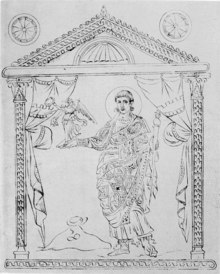
Constantius Gallus in a later copy of the
Chronography of 354
Flavius Claudius Constantius Gallus (ca. 325/326 –
354), better known as Constantius Gallus, was a member of the
Constantinian dynasty
and
Caesar
of the
Roman
Empire
(351-354). Gallus was
consul
three years, from 352 to 354.
//
Family
Son of
Julius Constantius
by his first wife Galla, Gallus’ paternal grandparents
were
Western Roman Emperor
Constantius Chlorus
and his second wife
Flavia Maximiana Theodora
.
Julius Constantius was also a half-brother of
Roman
Emperor
Constantine I
, and thus Gallus was a first cousin of Emperors
Constantine II
,
Constantius II
and
Constans
.
The older sister of Gallus, of unknown name, was the
first wife of Constantius II
. Julius Constantius had married a second wife,
Basilina, who had borne him a son, Flavius Claudius Iulianus, later emperor, and
known as
Julian
.
Appearance
Gallus was very good looking, with soft blond hair.
Youth
Gallus was born in
Massa Veternensis
,
Italia
, after his father had returned from exile. In 337, during the purges
that hit the imperial family after the death of Constantine I, Gallus saw his
father and his elder brother killed, probably by order of his cousin
Constantius. The only imperial males surviving were the three Emperors, Gallus,
and Julian, who were probably too young or ill (Banchich) to be a menace to
Constantius.
With regards to Gallus’ youth, the most accepted view is that
he lived with Julian under
Eusebius
, bishop of
Nicomedia
,
then in
Constantinople
since 340 (when Eusebius became bishop of the capital). After
341 (death of Eusebius), Constantius sent Gallus and Julian to the imperial
manor in Macellum
,
Cappadocia
.
An alternative view accepts hints from sources that want Gallus in Ephesus to
study, and then going to Macellum from an exile in Tralles.
Caesar
In 350,
Magnentius
had rebelled and killed the emperor
Constans
,
claiming the purple.
Constantius II
prepared to move against the usurper, but needed a
representative in the East, so he called Gallus at
Sirmium
,
raised him to the rank of
caesar
(15
March 351
),
gave him the name Constantius, and strengthened the bonds with his cousin
by allowing Gallus to marry his sister
Constantina
. Gallus and Constantina, who probably shared her brother’s aim
of controlling the young caesar, set up residence in
Antioch
.
During his rule, Gallus had to deal with a
Jewish
rebellion in
Judea
/Palestine
(see
War against Gallus
). The rebellion, possibly started before Gallus’
elevation to caesar, was crushed by Gallus’ general,
Ursicinus
, who ordered all the rebels slain.
Gallus was saved from an assassination plot by a woman, who
revealed that some members of her household were planning the murder. Some
sources, among whom are
Joannes Zonaras
, claim that this plot had been organized by Magnentius in
order to distract Constantius from Magnentius himself.
Some sources (Philostorgius)
claim Gallus’ generals won a campaign against the
Sassanids
. Others, basing their views on an almost-peaceful situation
between Sassanids and Romans, dismiss this claim. In 354, Gallus sent the
Comes
Orientis,
Nebridius, against the
Isaurians
,
who had been raiding the city of
Seleucia on the Tigris
.
As a consequence of the need to gather food for the troops of
a Persian campaign or because of drought, the grain supply in Antioch decreased.
In order to counter the higher price of grain, Gallus forced the passage of some
laws regardless of the opinion of the Senate, thus alienating the support of the
senatorial class of Antioch.
Ammianus Marcellinus
, a philo-senatorial writer, tells how the anger of the
people of Antioch for the famine was diverted by Gallus towards the
consularis
Syriae Theophilus, who was killed by the mob.
Ammianus reports also that Gallus and Constantina started
several trials for magic against wealthy people, ending in the execution of
innocents and in the confiscation of their wealth. The same source claims that
Gallus walked anonymously in Antioch by night, asking passersby for their
opinion on their caesar, while Julian records the great amount of time spent by
Gallus at the Hippodrome, probably to obtain popular support.
Doubting his cousin’s loyalty, Constantius reduced the troops
under Gallus, and sent the
Praetorian Prefect
Domitianus to Antioch to urge Gallus to go to Italy.
Different sources tell different stories, but all agree that Gallus arrested
Domitianus and the quaestor Montius who had come to his aid, and that the two
officers were killed.
The arrest of Montius led to the discovery of what seems to
be a plot to elevate an usurper against Gallus. The conspirators had the support
of two tribuni fabricarum (officers of the weapons factories) who had
promised the weapons for an uprising (Ammianus Marcellinus,
14.7.18
), and probably of the troops in Mesopotamia, as well as of the
rector of the province of Phoenice. All of those involved in the plot were
sentenced to death.
Fall and death
Constantius was informed of the trials in Antioch during a
campaign against the
Alamanni
.
Having signed a peace with the Germanic tribe, Constantius decided to settle the
matter with his cousin. First he summoned Ursicinus to the West, whom he
suspected to have been inciting Gallus in order to create the occasion for a
revolt and the usurpation of his own son.
Next, Constantius summoned Gallus and Constantina to Milan.
Constantina left first, in order to gain some of her brother’s trust, but died
at Caeni Gallicani in
Bithynia
.
Gallus, whose bonds to Constantius had been weakened, stayed in Antioch.
Constantius tried to lure Gallus, sending the tribunus scutariorum
Scudilo to tell Gallus that Constantius wanted to raise him to
Augustus
. Gallus desiring to finally obtain the rank of
Augustus
, took Constantius’s bait and left
Antioch
to
meet him. Gallus in an exhibition of his presumed soon to be Augustus powers,
staged a chariot race in Constantinople’s
Hippodrome
and crowned the victor, an honor reserved only for those that
are Augustus. This insolence of Gallus enraged Constantius, further adding to
his dislike for the upstart Caesar. In an attempt to further isolate Gallus from
any form of military protection, Constantius had the garrisons removed from the
towns in Gallus’s path.
When Gallus arrived to
Poetovio
in Noricum
, Barbatio
, an officer who had been supporting Gallus’ dismissal within
Constantius’ court, surrounded the palace of the caesar and arrested him,
stripping Gallus of the imperial robes, but assuring him that no harm would come
to him. Gallus was led to
Pola, Istria (now
Pula, Croatia). Here he was interrogated by some of the highest officials of
Constantius’ court, including the eunuch praepositus cubiculi Eusebius
and the agens in rebus
Apodemius
.
Gallus tried to put the blame of all of his actions on Constantina, but
Constantius sentenced him to death; The emperor later changed his mind, and
ordered the caesar to be spared, but Eusebius ordered that the news was not to
reach the executioners.
|















